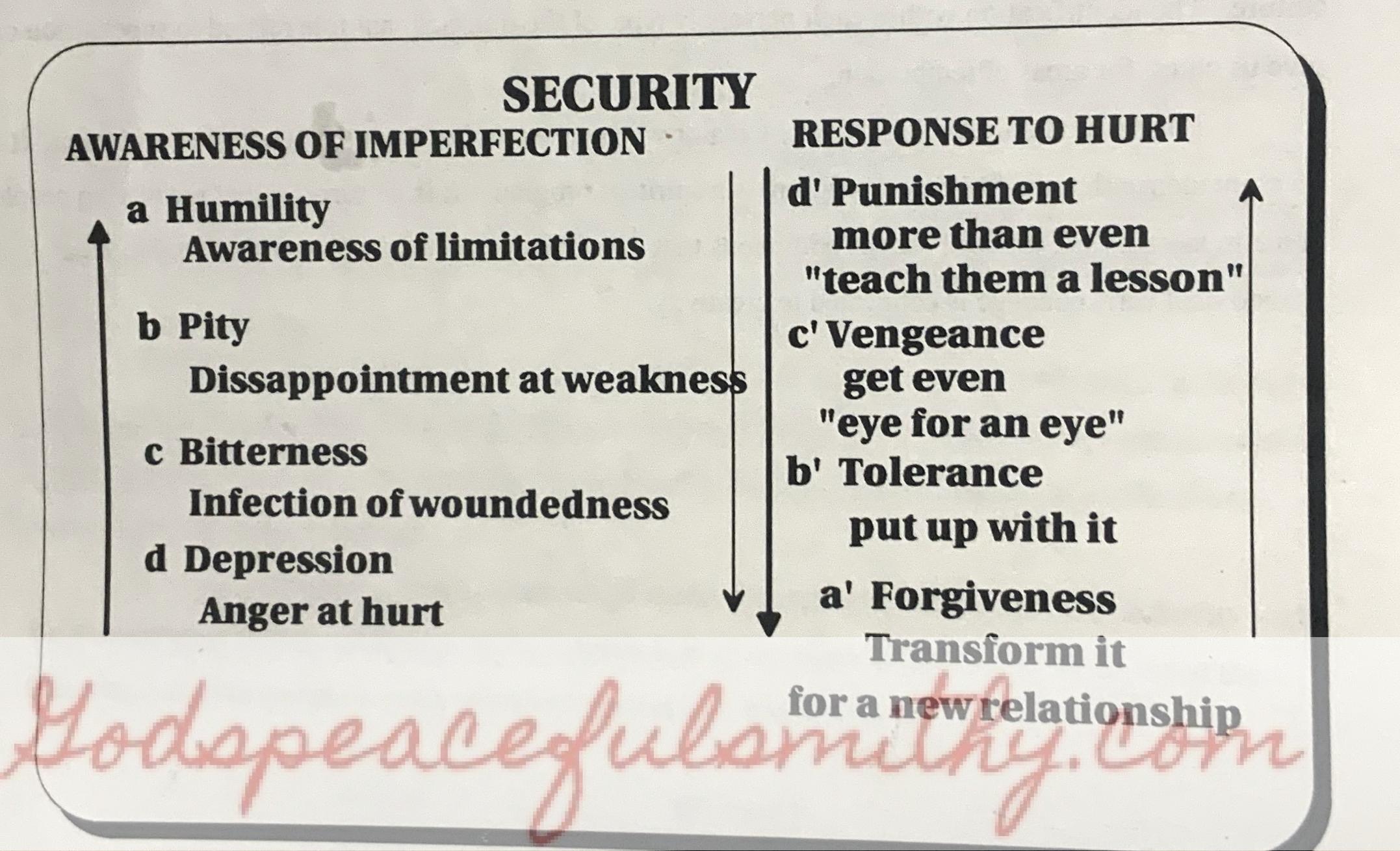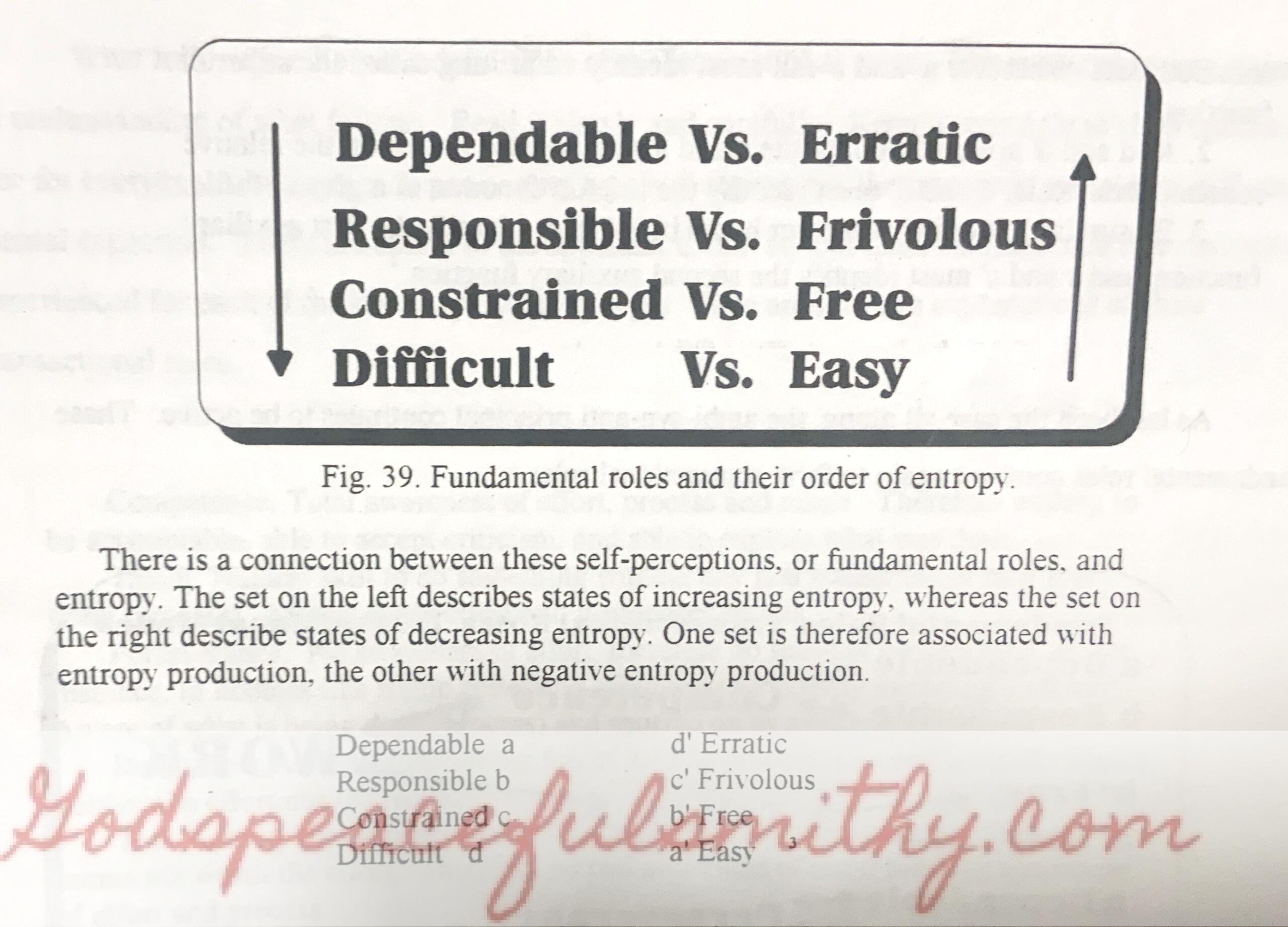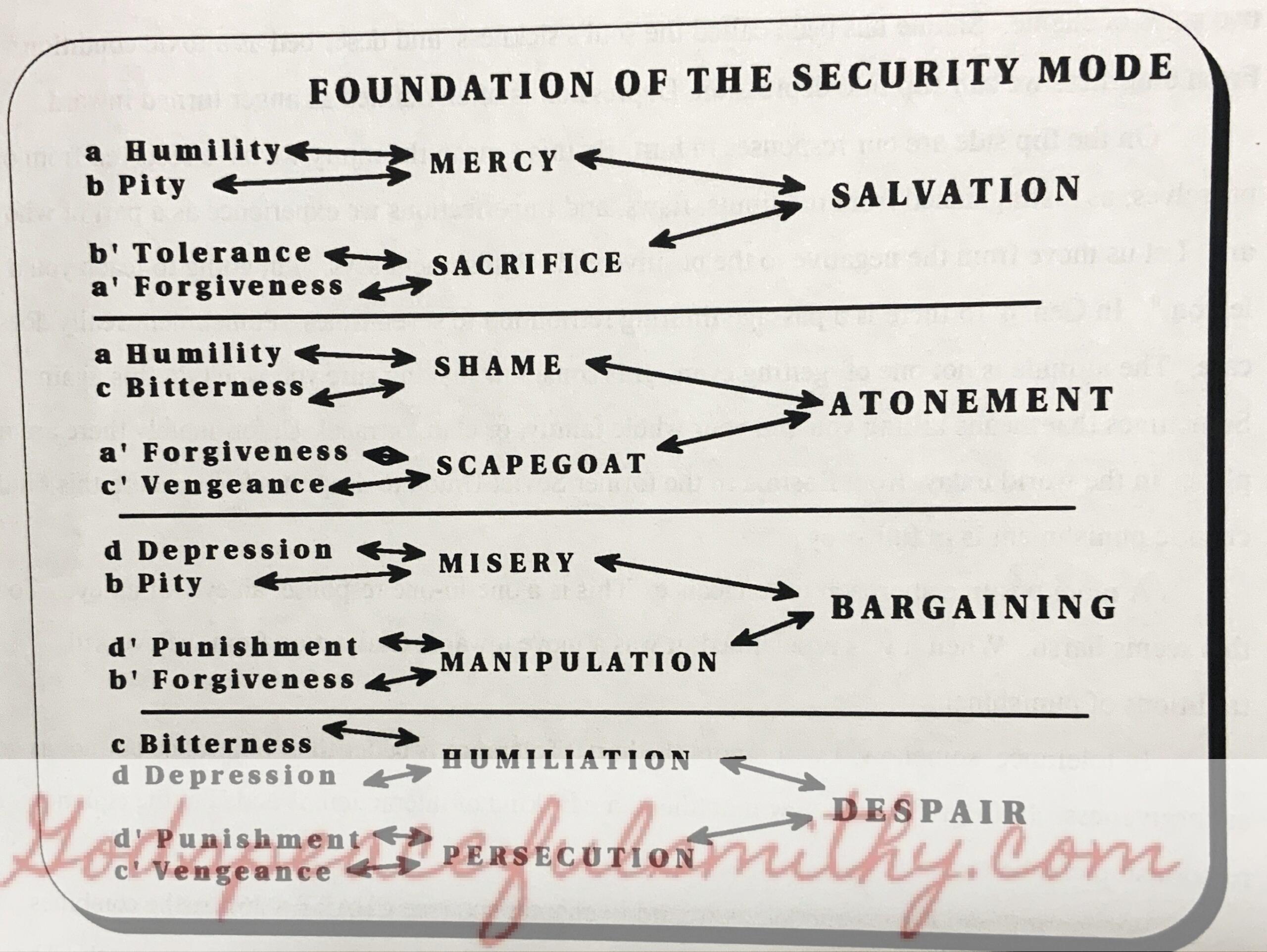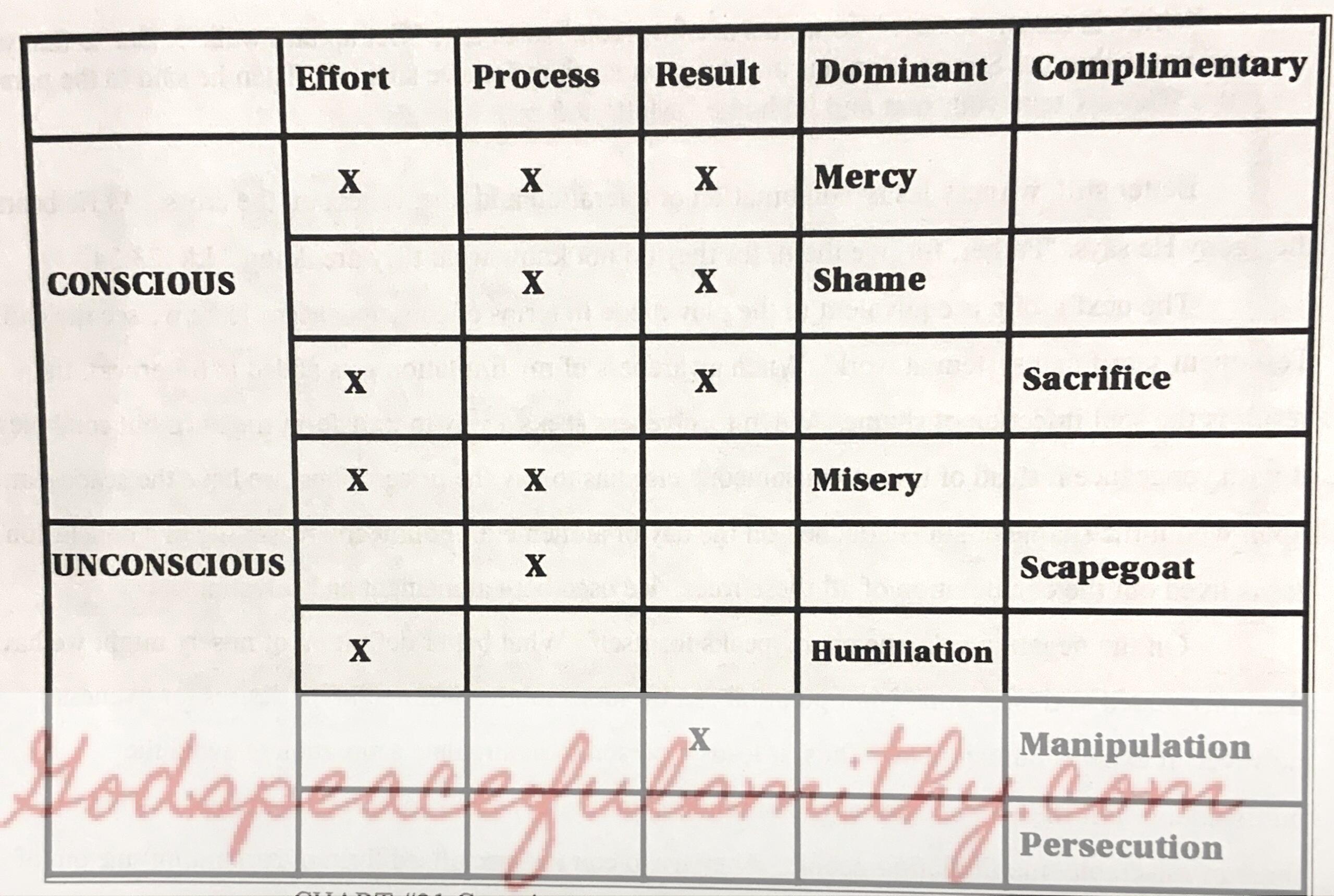
After thinking about the religious mode, I decided to think about what gives us Security. i’ll begin thinking about the idea of awareness of our own imperfection as a dichotomy with awareness of a response to hurt. I consider them to be key factors in our overall sense of security. As with the discussion of the first post in the series about the Religious Mode, I followed Lowens entropy scale.
 The highest level on this entropy scale of imperfection is humility. Simply stated, humility is knowing we are less than perfect. We have limitations. Movement down the scale brings us to pity. Patty is disappointment at weakness. It is at the level of pity we play the game of “Ain’t it awful.” The next lower response is bitterness. I called this an infection of woundedness. When we make Lowen’s connections to form the Security Mode, we will see that bitterness, combines with humility, as two sides of shame. Shame has been called the souls sickness, and described as a toxic condition. (You can look at John Bradshaw’s book Healing the Shame that Binds You.) From bitterness, we can slip into depression. Depression is often defined as anger turned inward. On the flipside are our responses to hurt. By this, I mean the injury we have received from outside ourselves; as distinguished from the limits, flaws, and imperfections, we experience as a part of who we are. Let us move from the negative to the positive end. Punishment says, “I’m going to teach you a lesson.” In genesis 4:15 there is a passage limiting retribution to seven times. Punishment really doesn’t care. The attitude is not one of getting even. It is somehow making sure you won’t do this again. Sometimes that means killing you, and your whole family, or clan, or race! Unfortunately, there are many places in the world today, from Bosnia in the former Soviet union to deepest Africa, where this kind of chaotic punishment is in full sway. A more positive approach is vengeance. This is a one to one response; an eye for an eye. To us, this seems harsh. When it was proclaimed, it was a move towards civilization from the overkill, traditions of punishment. In tolerance, somehow, I will ignore the hurt. Tolerance is better than vengeance, but not as good as forgiveness. Forgiveness, a nee ingredient, a new kind of indirection, is added to the equation; a relationship can be restored.
The highest level on this entropy scale of imperfection is humility. Simply stated, humility is knowing we are less than perfect. We have limitations. Movement down the scale brings us to pity. Patty is disappointment at weakness. It is at the level of pity we play the game of “Ain’t it awful.” The next lower response is bitterness. I called this an infection of woundedness. When we make Lowen’s connections to form the Security Mode, we will see that bitterness, combines with humility, as two sides of shame. Shame has been called the souls sickness, and described as a toxic condition. (You can look at John Bradshaw’s book Healing the Shame that Binds You.) From bitterness, we can slip into depression. Depression is often defined as anger turned inward. On the flipside are our responses to hurt. By this, I mean the injury we have received from outside ourselves; as distinguished from the limits, flaws, and imperfections, we experience as a part of who we are. Let us move from the negative to the positive end. Punishment says, “I’m going to teach you a lesson.” In genesis 4:15 there is a passage limiting retribution to seven times. Punishment really doesn’t care. The attitude is not one of getting even. It is somehow making sure you won’t do this again. Sometimes that means killing you, and your whole family, or clan, or race! Unfortunately, there are many places in the world today, from Bosnia in the former Soviet union to deepest Africa, where this kind of chaotic punishment is in full sway. A more positive approach is vengeance. This is a one to one response; an eye for an eye. To us, this seems harsh. When it was proclaimed, it was a move towards civilization from the overkill, traditions of punishment. In tolerance, somehow, I will ignore the hurt. Tolerance is better than vengeance, but not as good as forgiveness. Forgiveness, a nee ingredient, a new kind of indirection, is added to the equation; a relationship can be restored.  We can follow Lowen’s model, as we did in the previous post. As he combines dependable, plus responsible equals confidence or free plus easy equals talent and confidence plus talent equals work the result proves to be very interesting.
We can follow Lowen’s model, as we did in the previous post. As he combines dependable, plus responsible equals confidence or free plus easy equals talent and confidence plus talent equals work the result proves to be very interesting.  Perhaps I need to explain my logic. Humility ( awareness of limits) added to pity (disappointment at weakness) combine into the attitude of mercy. I am moved by disappointment and conditions that lead to your weakness, because I recognize I also have limits. I sympathize with your condition, and my empathy is engaged into the compassion of mercy. I imagine this to also be true with ourselves as the object of mercy. We need to get the movement to go in the other direction. If we can somehow recognize in ourselves pity, that we are, after all, limited human beings. We might be more merciful towards ourselves and others. Forgiveness (acting and reacting with love in my relationship with you) combined with tolerance (as if harm or did not happen) equals sacrifice. It is a common sense definition. Mercy, added to sacrifice, produces salvation. Mercy arouses compassion. Sacrifice put it into action. Then salvation happens. Here are the cry of blind Bartimaeus, “Jesus Christ, Son of David, Have mercy on me.” Mark 10:47 Better still, witness Jesus is combination of Tolerance and Forgiveness on the cross. As the Bears, the agony, he says., “Father, forgive them, for they do not know what they are doing.” Luke 23:34 The next group is at a slightly lower level of consciousness. Here we see, the Okd Testament sacrificial system at work. When awareness of my limitations gets added to bitterness, the result is the sole infection of shame. When forgiveness, seeks a way to transform the hurt, but combines it with vengeance, instead of love, then, someone else hast to pay the price. Thus, we have the scapegoat, upon whom the shame of sin is attached on the day of atonement. Followed my reasoning to a conclusion. Jesus lived out the combination of all these rules. He use both atonement and salvation. On the negative side, the church speaks for itself. What better definition of misery might we have that pity added to depression. Manipulation is a bit more subtle. Manipulation, desires, forgiveness, however, it expects punishment. Thus, it leads a person to manipulate the situation to avoid the punishment. Put these two together, manipulation and misery, and you get bargaining. I’ve met my share of miserable, manipulating people. They try to con me ( a specialized form of bargaining) out of some kind of benefit. There are many people who approach God in the same way. Bitterness and depression combine to make humiliation. The character I have in my mind size someone played an old movies by Peter Lorre. He is the villain’s servant. He is caught between his sour view of life in general, and the humiliating control of his master, who is often played by arch villain, Boris Karloff. Persecution is an expression of vengeance and punishment. Think of the concentration camp. The guards, and the warden, the whole system is arranged to intensify getting even. The movie Schindler‘s List portrays this very well. In more than one scene, we see the Nazi propaganda machine maligning the Jews. The spoken and unspoken message is, “They did us wrong. It’s time to get even.” Once humiliation is added to the mix, despair is a real possibility. Finally, what better way to describe the strategies of Satan, than with the words, bargaining, and despair. Think of all the folk tales that portray the devil enticing someone into a contract bargain. What better way to describe the strategies of Satan than with the words, bargaining, and despair. In exchange for his soul, the devil promises to rescue someone from a desperate situation. However, this partnership only leads them into a situation of even greater despair. Now we can also apply tne consciousness chart to this set of categories. As in the previous post the x equals consciousness.
Perhaps I need to explain my logic. Humility ( awareness of limits) added to pity (disappointment at weakness) combine into the attitude of mercy. I am moved by disappointment and conditions that lead to your weakness, because I recognize I also have limits. I sympathize with your condition, and my empathy is engaged into the compassion of mercy. I imagine this to also be true with ourselves as the object of mercy. We need to get the movement to go in the other direction. If we can somehow recognize in ourselves pity, that we are, after all, limited human beings. We might be more merciful towards ourselves and others. Forgiveness (acting and reacting with love in my relationship with you) combined with tolerance (as if harm or did not happen) equals sacrifice. It is a common sense definition. Mercy, added to sacrifice, produces salvation. Mercy arouses compassion. Sacrifice put it into action. Then salvation happens. Here are the cry of blind Bartimaeus, “Jesus Christ, Son of David, Have mercy on me.” Mark 10:47 Better still, witness Jesus is combination of Tolerance and Forgiveness on the cross. As the Bears, the agony, he says., “Father, forgive them, for they do not know what they are doing.” Luke 23:34 The next group is at a slightly lower level of consciousness. Here we see, the Okd Testament sacrificial system at work. When awareness of my limitations gets added to bitterness, the result is the sole infection of shame. When forgiveness, seeks a way to transform the hurt, but combines it with vengeance, instead of love, then, someone else hast to pay the price. Thus, we have the scapegoat, upon whom the shame of sin is attached on the day of atonement. Followed my reasoning to a conclusion. Jesus lived out the combination of all these rules. He use both atonement and salvation. On the negative side, the church speaks for itself. What better definition of misery might we have that pity added to depression. Manipulation is a bit more subtle. Manipulation, desires, forgiveness, however, it expects punishment. Thus, it leads a person to manipulate the situation to avoid the punishment. Put these two together, manipulation and misery, and you get bargaining. I’ve met my share of miserable, manipulating people. They try to con me ( a specialized form of bargaining) out of some kind of benefit. There are many people who approach God in the same way. Bitterness and depression combine to make humiliation. The character I have in my mind size someone played an old movies by Peter Lorre. He is the villain’s servant. He is caught between his sour view of life in general, and the humiliating control of his master, who is often played by arch villain, Boris Karloff. Persecution is an expression of vengeance and punishment. Think of the concentration camp. The guards, and the warden, the whole system is arranged to intensify getting even. The movie Schindler‘s List portrays this very well. In more than one scene, we see the Nazi propaganda machine maligning the Jews. The spoken and unspoken message is, “They did us wrong. It’s time to get even.” Once humiliation is added to the mix, despair is a real possibility. Finally, what better way to describe the strategies of Satan, than with the words, bargaining, and despair. Think of all the folk tales that portray the devil enticing someone into a contract bargain. What better way to describe the strategies of Satan than with the words, bargaining, and despair. In exchange for his soul, the devil promises to rescue someone from a desperate situation. However, this partnership only leads them into a situation of even greater despair. Now we can also apply tne consciousness chart to this set of categories. As in the previous post the x equals consciousness.  Mercy: this is a conscious act. True humility takes the strength of awareness to accept the truth. Pity, for another means we have notice the condition. Shame: much has been written recently about shame. The chart suggest some parallel learnings. In shame , we are acutely aware of the result. In fact, the result is so conscious, it is said that people build their whole identities on a shame based view of themselves. They will say of themselves “I am no good.” They identify with shame. It is who they are. Shame is, likewise, aware of the process. It is often connected to some kind of compulsive behavior. The shame based person is aware of this behavior and tries to stop. When it is impossible to stop the drinking, acting out in socially unacceptable ways, the shamed based person is reinforced in the awareness of the result. ‘I am a bad person.” In the unconscious category, we see Shane based behavior has no awareness of effort. Shame seems to have a life of its own. Sacrifice: forgiveness and tolerance, take awareness. It takes the decision of the will to choose to absorb hurt. However, as the chart indicates, there is one level of unconsciousness, the effort. We may choose to accept sacrifice, but it is done to us. This reminds me of the warning to first century Christians not to seek martyrdom. If sacrifice is one’s calling, Grace is given to endure. Yet God, it’s not seeking sacrifice with no purpose. Misery: in misery we have all process. I know I am unhappy. I take great pains to be sure I stay this way, but it is effortless. Furthermore, this misery may be killing me spiritually, emotionally, even physically, but I don’t know it. Frankly, I don’t care. I am unaware of the results. Scapegoat: people are aware of the process involved in choosing, and seeking out a scapegoat. This is true when the victim is a real goat, as a designated fall guy, or a group. The psychological principle of projection is involved. However, the people looking for a scapegoat are saying. “We’ve got a problem. it’s got to be somebody’s fault. LET’s sacrifice him!” They are well aware of what is happening. However, they are blithely ignorant of the results. Who feels for the goat? After all it is banished from consciousness to die in the wilderness. Effort is also unconscious. Those seeking a scapegoat are tireless in their efforts. They persevere. Humiliation: here the awareness is all in the effort. I feel like a no good, lowdown, slime of a person. The awareness is all in the effort. I feel like a no good, lowdown, slime of a person. I don’t know who did it to me or how it happened, but I’m nobody and life is hard. Manipulation: this can easily be explained using our short. Manipulators are often what. M. Scott Peck called them People of the Lie. They have conned so many people, so many times, they really believe, they are sincere. Without effort, their focus is all on. What can I get? (The result) Persecution: this takes the scapegoat one notch lower. Now I’m so skilled at blaming, it is entirely slipped into denial. Either, I’m sure I’m not doing it, or I’ve convinced myself, you deserve it. In my mind, it is simply justice, and not persecution at all. Thanks for reading this complicated information to the end be looking for the next installment: The Judgment Mode.
Mercy: this is a conscious act. True humility takes the strength of awareness to accept the truth. Pity, for another means we have notice the condition. Shame: much has been written recently about shame. The chart suggest some parallel learnings. In shame , we are acutely aware of the result. In fact, the result is so conscious, it is said that people build their whole identities on a shame based view of themselves. They will say of themselves “I am no good.” They identify with shame. It is who they are. Shame is, likewise, aware of the process. It is often connected to some kind of compulsive behavior. The shame based person is aware of this behavior and tries to stop. When it is impossible to stop the drinking, acting out in socially unacceptable ways, the shamed based person is reinforced in the awareness of the result. ‘I am a bad person.” In the unconscious category, we see Shane based behavior has no awareness of effort. Shame seems to have a life of its own. Sacrifice: forgiveness and tolerance, take awareness. It takes the decision of the will to choose to absorb hurt. However, as the chart indicates, there is one level of unconsciousness, the effort. We may choose to accept sacrifice, but it is done to us. This reminds me of the warning to first century Christians not to seek martyrdom. If sacrifice is one’s calling, Grace is given to endure. Yet God, it’s not seeking sacrifice with no purpose. Misery: in misery we have all process. I know I am unhappy. I take great pains to be sure I stay this way, but it is effortless. Furthermore, this misery may be killing me spiritually, emotionally, even physically, but I don’t know it. Frankly, I don’t care. I am unaware of the results. Scapegoat: people are aware of the process involved in choosing, and seeking out a scapegoat. This is true when the victim is a real goat, as a designated fall guy, or a group. The psychological principle of projection is involved. However, the people looking for a scapegoat are saying. “We’ve got a problem. it’s got to be somebody’s fault. LET’s sacrifice him!” They are well aware of what is happening. However, they are blithely ignorant of the results. Who feels for the goat? After all it is banished from consciousness to die in the wilderness. Effort is also unconscious. Those seeking a scapegoat are tireless in their efforts. They persevere. Humiliation: here the awareness is all in the effort. I feel like a no good, lowdown, slime of a person. The awareness is all in the effort. I feel like a no good, lowdown, slime of a person. I don’t know who did it to me or how it happened, but I’m nobody and life is hard. Manipulation: this can easily be explained using our short. Manipulators are often what. M. Scott Peck called them People of the Lie. They have conned so many people, so many times, they really believe, they are sincere. Without effort, their focus is all on. What can I get? (The result) Persecution: this takes the scapegoat one notch lower. Now I’m so skilled at blaming, it is entirely slipped into denial. Either, I’m sure I’m not doing it, or I’ve convinced myself, you deserve it. In my mind, it is simply justice, and not persecution at all. Thanks for reading this complicated information to the end be looking for the next installment: The Judgment Mode.